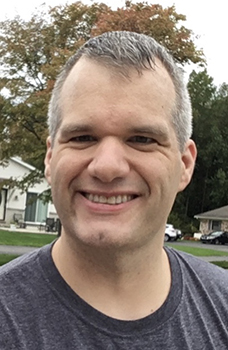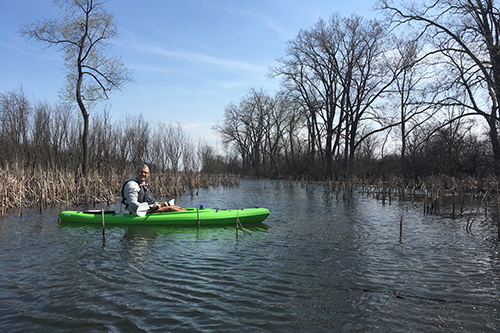Aquaculture, or fish farming, is a $21 million industry in Wisconsin. Wisconsin Sea Grant has a long history of nurturing the growth of aquaculture through research and public outreach. Coupled with Sea Grant efforts related to Great Lakes commercial fishing, these activities help Wisconsin producers offer consumers a sustainable, domestic alternative to imported fish and seafood.
A fresh chapter in this history is the Wisconsin Sea Grant Keillor Fellowship in Aquaculture, created in partnership with the University of Wisconsin-Stevens Point Northern Aquaculture Demonstration Facility (NADF), where the position is based. The Bayfield facility is a national leader in aquaculture research.

Dr. Patrick Blaufuss (submitted photo)
The inaugural fellow, Dr. Patrick Blaufuss, began his two-year position in September. He holds a doctorate in animal physiology from the University of Idaho, where his research focused on nutrition and physiology in rainbow trout. He’s also a graduate of North Dakota State University and Southern Illinois University, where he earned his bachelor’s and master’s degrees in zoology, respectively.
One of his greatest satisfactions, said Blaufuss, is seeing laboratory research provide useful results for fish farmers. “I’m excited to get experience with the aquaculture industry in the Great Lakes region… and to get more experience with commercial producers and the commercial setting, helping them refine what they do. Applying what we do in the lab out in the real world is very important,” said Blaufuss.
One of his top priorities will be analyzing data from past and current NADF projects and preparing manuscripts for publication in scientific journals.
Said Greg Fischer, NADF assistant director and research program manager, “Having Patrick on board as our new Sea Grant fellow will directly impact getting our completed research projects analyzed and published in a timely manner, which allows us to share results with the aquaculture industry and scientific community more rapidly, and to move aquaculture forward with confidence.”
Dr. Chris Hartleb, a UW-Stevens Point professor of fisheries biology and NADF co-director, echoed those thoughts. “Pat’s background and knowledge will assist us with completing past projects, restructuring current projects and expanding our ability to provide assistance to many aquaculturists with new projects.”
Blaufuss’ prior experience includes restoration aquaculture work with burbot in Idaho, where that species was almost extirpated from the Kootenai River watershed due to the operation of a dam that led to increased water temperatures (burbot need very cold water to spawn successfully). The recreational burbot fishery there had been closed since 1992. As part of the restoration work, Blaufuss served as a consultant to the Kootenai Tribe of Idaho, which runs a commercial-scale fish hatchery. Employing results from University of Idaho lab research, Blaufuss helped the tribe with its first season of burbot aquaculture. Subsequent years of restocking efforts by the Kootenai Tribe have succeeded in restoring burbot populations to a level that recreational fishing is once again possible for anglers.
Commented Blaufuss, “I came out there [to the tribal hatchery] regularly throughout their first season, since there are multiple steps in burbot culture, and you have to be aware of them.” Burbot are extremely carnivorous, so cannibalization can be an issue, and they also have a longer larval rearing period compared to some other species. “It was very fulfilling to help them through each stage of the culture, and to see how our smaller-scale research data could be applied to a full-size commercial setting.”

Blaufuss kayaking on Lake Erie near Gibraltar, Mich. (submitted photo)
Currently, Blaufuss is writing a manuscript about previous NADF work on commercial diets for larval walleye and saugeye (a walleye-sauger hybrid that also occurs in the wild). “It’s so important that producers know the best diet to feed these larval fish,” he said. (Wisconsin Sea Grant funded this research in its 2018-20 grant cycle; read more about it here.)
He’s also working on a nanobubble oxygenation project, a novel way of introducing oxygen into aquaculture systems. “We’re looking at how it affects fish health, growth and other parameters,” said Blaufuss. The National Sea Grant Office is supporting the nanobubble work; read more about it here.
While much of his work is remote at the moment due to the ongoing pandemic, Blaufuss said that the two-year commitment at NADF gives him a good chunk of time to work with fish species and aquaculture systems that are new to him, as well as boost the facility’s research output.
It’s all part of Sea Grant and NADF’s broader goals to train professionals—from undergraduate students to postdoctoral fellows like Blaufuss—and support sustainable aquaculture that is backed by cutting-edge science. When the public health crisis abates, said Hartleb, Blaufuss will be able to get out to conferences, workshops and farms to enhance connections and share NADF information.
Said Fischer, “Wisconsin Sea Grant has been a great partner in all that we do, and we look forward to the future and continued partnership and cooperation.”





